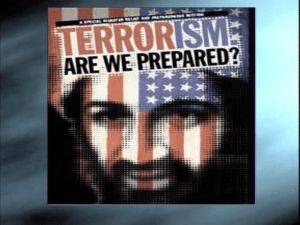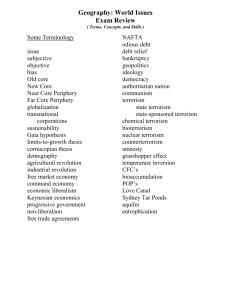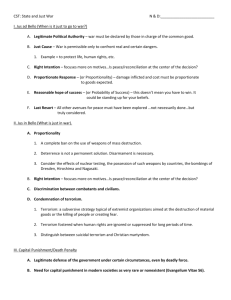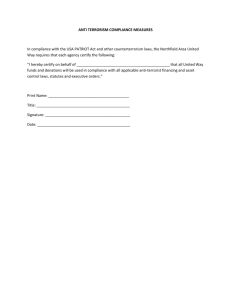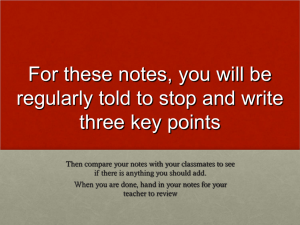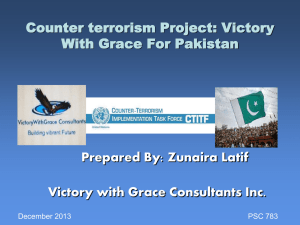Course Syllabus - University of Rochester
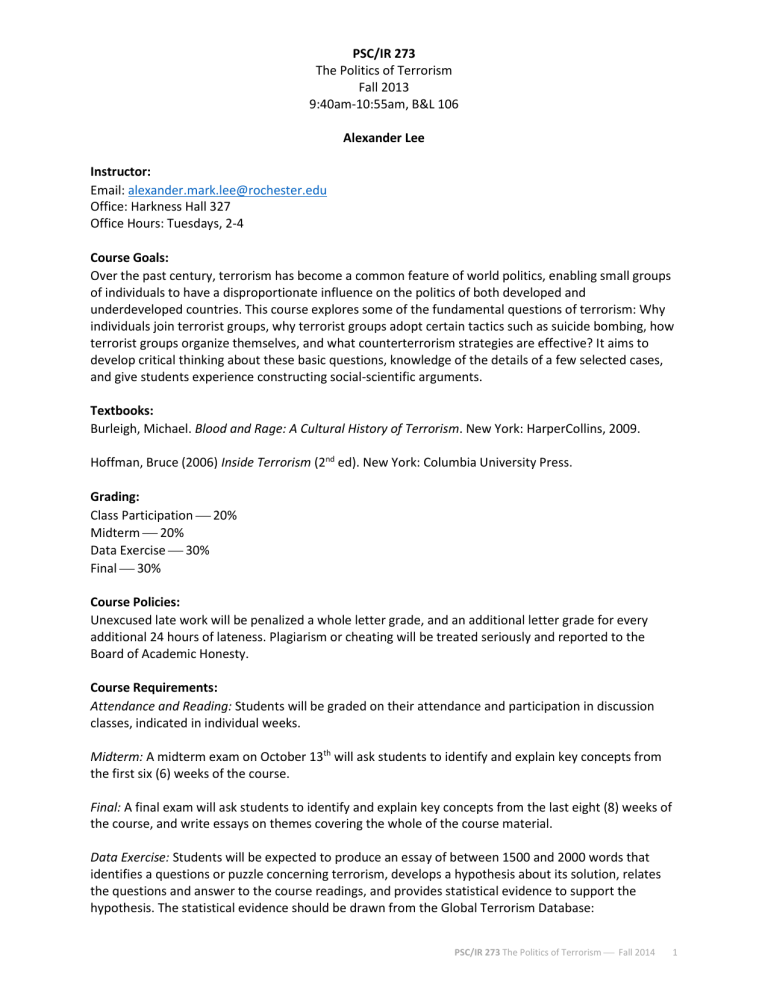
Instructor:
Email: alexander.mark.lee@rochester.edu
Office: Harkness Hall 327
Office Hours: Tuesdays, 2-4
Course Goals:
PSC/IR 273
The Politics of Terrorism
Fall 2013
9:40am-10:55am, B&L 106
Alexander Lee
Over the past century, terrorism has become a common feature of world politics, enabling small groups of individuals to have a disproportionate influence on the politics of both developed and underdeveloped countries. This course explores some of the fundamental questions of terrorism: Why individuals join terrorist groups, why terrorist groups adopt certain tactics such as suicide bombing, how terrorist groups organize themselves, and what counterterrorism strategies are effective? It aims to develop critical thinking about these basic questions, knowledge of the details of a few selected cases, and give students experience constructing social-scientific arguments.
Textbooks:
Burleigh, Michael. Blood and Rage: A Cultural History of Terrorism. New York: HarperCollins, 2009.
Hoffman, Bruce (2006) Inside Terrorism (2 nd ed). New York: Columbia University Press.
Grading:
Class Participation
20%
Midterm
20%
Data Exercise
30%
Final
30%
Course Policies:
Unexcused late work will be penalized a whole letter grade, and an additional letter grade for every additional 24 hours of lateness. Plagiarism or cheating will be treated seriously and reported to the
Board of Academic Honesty.
Course Requirements:
Attendance and Reading: Students will be graded on their attendance and participation in discussion classes, indicated in individual weeks.
Midterm: A midterm exam on October 13 th will ask students to identify and explain key concepts from the first six (6) weeks of the course.
Final: A final exam will ask students to identify and explain key concepts from the last eight (8) weeks of the course, and write essays on themes covering the whole of the course material.
Data Exercise: Students will be expected to produce an essay of between 1500 and 2000 words that identifies a questions or puzzle concerning terrorism, develops a hypothesis about its solution, relates the questions and answer to the course readings, and provides statistical evidence to support the hypothesis. The statistical evidence should be drawn from the Global Terrorism Database:
PSC/IR 273 The Politics of Terrorism
Fall 2014 1
http://www.start.umd.edu/gtd/ Additional details on the Data exercise will be explained in class on
September 29 th .
Readings
Week 1: Introduction
Introduction: September 1 st
Weeks 1-2: Definitions
Lecture: September 3rd
Discussion: September 8th
Readings:
Hoffman, Bruce (2006). “Defining Terrorism” (Chapter 1). In Inside Terrorism (2 nd ed). New York:
Columbia University Press, 1-41.
Tilly, Charles (2004). “Terror, Terrorism, Terrorists.” Sociological Theory 22(1): 5-13.
Weeks 2-3: The History of Terrorism
Lecture: September 10 th , September 15 th
Readings:
Hoffman, Bruce (2006) Inside Terrorism, 2nd ed. New York: Columbia University Press, 63-80. 257-295
David C. Rapoport, “The Four Waves of Modern Terrorism,” in Audrey Kurth Cronin and James M. Ludes,
Eds., Attacking Terrorism: Elements of a Grand Strategy, pp. 46-73.
Week 3: The Red Army Faction
Lecture: September 17th
Readings:
Burleigh, Michael. Blood and Rage: A Cultural History of Terrorism. New York: HarperCollins, 2009.
P.221-267.
Donatella della Porta, Social Movements, Political Violence, and the State: A Comparative Analysis of
Italy and Germany. Cambridge: Cambridge UP, 1995. 36-50, 137-142
Week 4: The IRA
Lecture: September 22 nd
Discussion: The IRA and the RAF, September 24 th
Readings:
Burleigh, Michael. Blood and Rage: A Cultural History of Terrorism. New York: HarperCollins, 2009.
P.287-345.
Sanchez-Cuenca, Ignacio. "The dynamics of nationalist terrorism: ETA and the IRA." Terrorism and
Political Violence 19.3 (2007): 289-306.
PSC/IR 273 The Politics of Terrorism
Fall 2014 2
Week 5: The Strategies of Terrorist Groups
Lecture: September 29 th
Discussion: October 1st
Readings:
Crenshaw, Martha (1998). “The Logic of Terrorism: Terrorist behavior as a product of strategic choice.”
(Chapter 1). In Walter Reich, Ed. Origins of Terrorism: Psychologies, Ideologies, Theologies,
States of Mind (2nd ed.), 7-24.
Kydd, Andrew and Barbara Walter (2006). “The Strategies of Terrorism.” International Security 31(1): 49-
80.
Week 6: The Data Exercise
Lecture: October 8th
Week 7: Statistical Methods
Midterm October 13th
Lecture: How to Read Statistical Papers, October 15 th
Week 8: The Collective Causes of Terrorism
Lecture: October 20 th
Discussion: October 22nd
Readings:
Li, Quan. "Does democracy promote or reduce transnational terrorist incidents?." Journal of Conflict
Resolution 49.2 (2005): 278-297.
Piazza, James A. "Incubators of Terror: Do Failed and Failing States Promote Transnational Terrorism?."
International Studies Quarterly 52.3 (2008): 469-488.
Week 9: The Individual Causes of Terrorism
Lecture: October 27th
Discussion: October 29th
Readings:
Krueger, Alan B., and Jitka Maleckova. "Education, Poverty and Terrorism: Is there a causal connection?." The Journal of Economic Perspectives 17.4 (2003): 119-144.
Lee, Alexander. "Who Becomes a Terrorist?: Poverty, Education, and the Origins of Political Violence."
World Politics 63.02 (2011): 203-245.
Gambetta, Diego, and Steffen Hertog. "Engineers of Jihad." (2007).
Week 10: Suicide Terrorism
Lecture: November 3 rd
Discussion: November 5th
PSC/IR 273 The Politics of Terrorism
Fall 2014 3
Readings:
Hoffman, Bruce (2006) Inside Terrorism, 2nd ed. New York: Columbia University Press, 131-171.
Pape, Robert A. "The strategic logic of suicide terrorism." American Political Science Review 97.3 (2003):
343-361.
Ashworth, Scott, et al. "Design, inference, and the strategic logic of suicide terrorism." American Political
Science Review 102.02 (2008): 269-273.
Week 11: The Palestinians
No Class November 10 th
Lecture: November 12th
Readings:
Burleigh, Michael. Blood and Rage: A Cultural History of Terrorism. New York: HarperCollins, 2009. P.
152-188, 380-396
Hassan, Nasra. “An Arsenal of Believers.” New Yorker, November 19, pp. 36–41. 2001.
Week 12: Al-Qaida
Lecture: November 17 th
Discussion: The PLO and Al-Qaida, November 19 th
Readings:
The 9/11 Commission Report (2004). New York: W. W. Norton, 47-70; 145-173; 215-253.
Lawrence, Bruce (2005). Messages to the World: The Statements of Osama Bin Laden. London: Verso,
23-30; 58-62.
Week 13
Thanksgiving, No Class
Week 14: Structure, Weapons and Funding
Lecture: December 1 st
Discussion: December 3rd
Readings:
Koschade, Stuart. "A social network analysis of Jemaah Islamiyah: The applications to counterterrorism and intelligence." Studies in Conflict & Terrorism 29.6 (2006): 559-575.
Shapiro, Jacob N., and David A. Siegel. "Underfunding in terrorist organizations." International Studies
Quarterly 51.2 (2007): 405-429.
Hoffman, Bruce (2006). “Chapter 8” In Inside Terrorism (2 nd ed). New York: Columbia University Press,
229-256.
PSC/IR 273 The Politics of Terrorism
Fall 2014 4
Week 15: Counterterrorism
Lecture: December 8 th ,
Discussion: December 10 th
Readings:
Stern, Jessica. "Mind over martyr: How to deradicalize Islamist extremists." Foreign Affairs (2010): 95-
108.
Bergen, Peter, and Katherine Tiedemann. "Washington's Phantom War: The Effects of the US Drone
Programs in Pakistan." Foreign Affairs 90 (2011): 12-18
Kaplan, Robert D. "Hunting the Taliban in Las Vegas." Atlantic Monthly 298.2 (2006): 81-83.
Zussman, Asaf, and Noam Zussman. "Assassinations: Evaluating the effectiveness of an Israeli counterterrorism policy using stock market data." The Journal of Economic Perspectives 20.2
(2006): 193-206.
Final Exam: Friday, December 18 th , 4pm
PSC/IR 273 The Politics of Terrorism
Fall 2014 5


